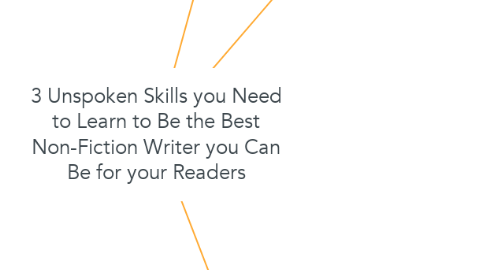
1. Empathy
1.1. Definition
1.1.1. the ability to understand and share the feelings of another
1.2. How can I use Empathy in my writing?
1.2.1. Prefer using “We” over “I”
1.2.1.1. People need to see that you understand their problems and feelings
1.2.1.2. They have to believe that you are the right person to give them advice.
1.2.1.3. When you use the word “we”, you show them that they’re not alone in this and other people have overcome it.
1.2.1.4. Toss in your personal story but also try to include other people who had similar results.
1.2.2. Use emotion words / Name feelings
1.2.2.1. Ask your audience: “Are you feeling <insert emotion here>”.
1.2.3. Drop facts and statistics
1.2.3.1. A fact-based article does not drive empathy.
1.2.3.2. Only use facts and statistics if it helps reinforce the fact that the reader is not alone in this.
2. Marketing
2.1. Definition
2.1.1. the activity, set of institutions, and processes for creating, communicating, delivering, and exchanging offerings that have value for customers, clients, partners, and society at large.
2.2. How can I use Marketing in my writing?
2.2.1. Don’t use clickbait headlines
2.2.1.1. It’s not clickbait if the content reflects the headline, no matter how sales-y the headline feels.
2.2.1.2. Refine the headline after writing the story.
2.2.2. Don’t be pushy
2.2.2.1. It’s okay to mention your products or services in your article but it shouldn’t be the object of the story.
2.2.3. Be credible
2.2.3.1. If you’re giving advice to users, think about how they perceive you.
2.2.4. Be clear on the value they’ll get out of it
2.2.4.1. Early on in your article, it has to be clear what the main takeaway is. If possible, you should even answer that in the headline.
2.2.4.2. Make sure it’s clear and believable.
3. Storytelling
3.1. Definition
3.1.1. The act and skills of presenting stories and tales
3.2. Think about great storytellers you know:
3.2.1. What do they have in common?
3.2.2. How do they behave?
3.2.3. What kinds of stories do they tell?
3.2.4. How do they tell the story?
3.2.5. Answering these questions will help you better understand the commonalities between great storytellers.
3.3. How can I use Storytelling in my writing?
3.3.1. Use power words
3.3.2. Use Onomatopoeia
3.3.2.1. Examples: bloop, splash, spray, sprinkle, squirt, dribble, drip, drizzle, bam, bang, clang, clank, clap, clatter, click, clink, ding, jingle, screech, slap, thud, thump, and a whole lot more.
3.3.3. Pay attention to details
3.3.3.1. When recollecting an event, try to think of as many details as you can, and when it matters, include it in your story.
3.3.4. Focus on key elements only
3.3.4.1. Make your story about one object.
3.3.4.2. Have a clear message on what the one true takeaway is for reading a story.
3.3.5. Use breaks
3.3.5.1. When you write your paragraphs, put emotions and questions on separate lines.
3.3.5.2. Try to keep your paragraphs to 3–4 lines as much as possible for greater flow and clarity.
